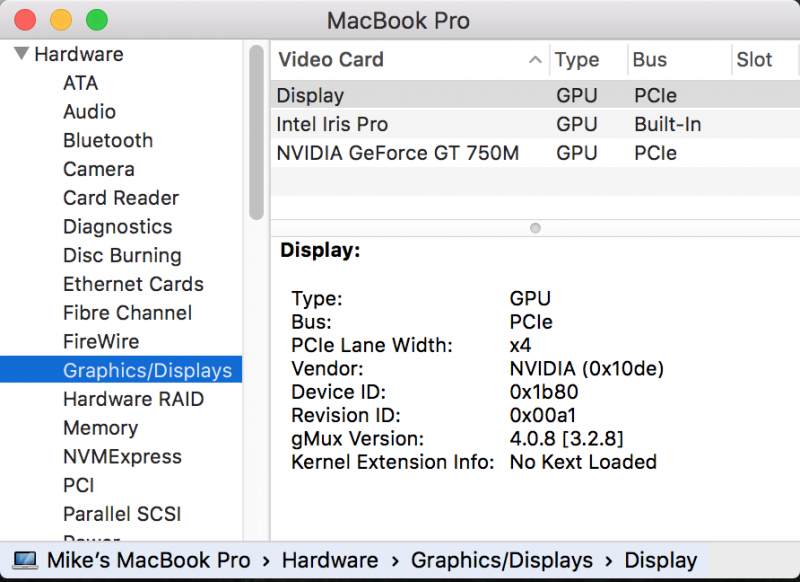-
Posts
14 -
Joined
-
Last visited
Recent Profile Visitors
The recent visitors block is disabled and is not being shown to other users.
Mike Thorn's Achievements

Settling In (2/7)
2
Reputation
-
It'll be the web drivers. Once you install the GeForce experience or whatever it's called on macOS (not at my laptop at the moment), you will be able to install the latest web driver, which does have whatever mac support Nvidia currently has (currently only fully complete for the Kepler architecture). I believe the latest version is 367.15.10.25f02. It won't let me send you a PM, any idea why? Puzzled.
-
I'm not a drivers expert, but I would imagine that it might be possible to get the card running in a very basic form with the Maxwell-series drivers, but you definitely would not be able to take advantage of the Pascal-series features and benefits. That's over my head though. I had had hoped that 10.12 Sierra would have some support, but it seems that Nvidia has not put a great amount of effort into it. I'll PM you on the akitio.
-
Damien - as far as I'm aware, we still don't have Pascal drivers on macOS yet. So, the 1080 won't work (at least not without some much more fiddle hacking, I imagine). Right now for Mac use you'd be better off picking up a GTX 980 or Titan, as those have full Mac support. Or, if you're in Premiere, get the best Radeon you can get - while OpenCL is not as hot as CUDA for hardware acceleration in the Adobe suite, it has native macOS support and might save you some grief. On on another note, I ended up building a full Windows tower specifically for editing, so my Akitio sits idle. I'll make you a good deal...
-
@jagung No, not yet. As I mentioned earlier, tweaking the root bridge manually is a bit over my head. At the moment I'm 95% finished with a huge work project (using this macbook as my primary workhorse) so I don't dare do anything fiddly right now. Next week it'll all be over and experimentation can resume. Supposedly there will be a good chance of getting GTX1080 support on the Mac side when macOS Sierra drops in September, so I'm signed up for the public beta to test that as soon as it's available. Supposedly nVidia has eGPU-over-TB3 support already built into the current web drivers so I'd expect that Sierra will complete the circle. I'd still like to get a copy of Setup 1.3 if that's possible.
-
Somewhere along the line, amid multiple reboots, I discovered that Nvidia GeForce Experience had triggered an auto-update availability to v368. This installed relatively smoothly, as before, and with a couple reboots to clear out the cobwebs and let Windows 7 update whatever drivers it felt able to handle, the system is running v368 just fine. However, Windows is now throwing a Code 12 (insufficient resources) on the GTX1080. It recognizes it as a display adapter alongside the dGPU but is not allowing output from it. From my research here, it seems I can either do some very fiddly things with a DSDT override (that I don't completely understand), or I can use @Tech Inferno Fan's Setup 1.3 to extend the root bridge to 36-bit space. It's all a bit over my head, but it seems using Setup 1.3 has the least risk of requiring extensive debugging, amirite? However, is Setup1.3 available again or is nando unfortunately still recovering? Not having been here long I don't have a grasp of the timeline. Or am I missing something else that might be worth trying?
-
Mike Thorn changed their profile photo
-
So for those that come to the party later, here are some details about what I've discovered throughout my journey that may aid in the speedier adaptation of ways and means to the new cards... I was able to get the card running with relatively no trouble on an older HP desktop I had in the office. Inserted the card, fired it up, downloaded the v368 drivers, installed no problem, rebooted and I was enjoying crystal-clear 3840x2160 30hz output over HDMI on the first try. So for a benchmark, there it is. (ironically, I refreshed my Windows Experience assessment on a whim, and even with the new card - replacing an ancient GT 8600 - the score didn't change!). What it did allow me to find out, however, was the Hardware ID information for the card through Windows. Somewhat surprisingly, it listed the subsystem ID as 0000000. This was confirmed through the Nvidia Control Panel. My hope was to confirm the full ID string so I could modify the v368 driver INF files on my macbook Win7 side, and trick the v368 driver install to execute as described in this video, and elsewhere (having experienced that "hardware not found" error on the previous attempt). Curiously, I found a few things different from that walkthrough. First of all, there are 56 INF files in the extracted setup folder, and exactly 1 of them contains anything remotely like the hardware strings shown in the video (nv_dmi.inf). This contains a section as follows: [Manufacturer] %NVIDIA_A% = NVIDIA_Devices,NTamd64.6.0,NTamd64.6.1,NTamd64.6.2,NTamd64.6.3,NTamd64.10.0 [NVIDIA_Devices.NTamd64.6.1] %NVIDIA_DEV.1B80.068B.1028% = Section364, PCI\VEN_10DE&DEV_1B80&SUBSYS_068B1028 [NVIDIA_Devices.NTamd64.6.0] [NVIDIA_Devices.NTamd64.6.3] %NVIDIA_DEV.1B80.068B.1028% = Section366, PCI\VEN_10DE&DEV_1B80&SUBSYS_068B1028 [NVIDIA_Devices.NTamd64.6.2] %NVIDIA_DEV.1B80.068B.1028% = Section365, PCI\VEN_10DE&DEV_1B80&SUBSYS_068B1028 Knowing already that _1B80 is the GTX1080 identifier, it seems that the driver is already prepared to enable the card. Clearly the syntax of this section has changed from previous versions. I would syspect that subsys_068B is actually the correct identifier for the card, but why that would not appear in the Nvidia Control Panel is beyond me. However, since my desktop expedition revealed a mysterious "00000000" subsys ID, I inserted duplicate lines in each section above with that section appropriately modified. Can't hurt. A file called nv_dispi.inf also contains a reference to the 1080, but in a less complete form: [Manufacturer] %NVIDIA_A% = NVIDIA_Devices,NTamd64.6.0,NTamd64.6.1,NTamd64.6.2,NTamd64.6.3,NTamd64.10.0 [NVIDIA_Devices.NTamd64.6.1] %NVIDIA_DEV.1B80% = Section032, PCI\VEN_10DE&DEV_1B80 [NVIDIA_Devices.NTamd64.6.0] %NVIDIA_DEV.1B80% = Section031, PCI\VEN_10DE&DEV_1B80 [NVIDIA_Devices.NTamd64.6.3] %NVIDIA_DEV.1B80% = Section137, PCI\VEN_10DE&DEV_1B80 [NVIDIA_Devices.NTamd64.6.2] %NVIDIA_DEV.1B80% = Section033, PCI\VEN_10DE&DEV_1B80 I left this file alone. On further perusal, it's worth noting that a file called "ListDevices.txt" in the setup root folder has a list of all the .inf files, and specifically lists these two .inf files as containing the GTX 1080 information (and no others). This may save some of you time when scrubbing around later! Unfortunately this is not enough to permit the setup executable to continue doing good deeds and it fails out during the compatibility check as before.
-
I would assume that the drivers are not cumulatively functional, i.e. the 346.03.06 drivers aren't enough to enable basic functionality, but not the full optimized capability of the card? I should mention that I already have the machine set up with a Win7 bootcamp, but got overwhelmed with the volume of info and different approaches to getting the eGPU running on that side and stopped. It seems there *are* 1080 drivers for Windows already, and even for Win7, but I was starting to lose my mind with all the ways it could be done...
-
Thanks to the guides and builds here I've been assembling pieces+parts for an eGPU build for a few weeks now. My brand new GTX 1080 arrived yesterday and I've been pretty excited to fire it up. Last night I completed the necessary modifications of the Akitio box and purchased a Thermaltake SP-650P Smart 650w PSU. I've jumpered this and confirmed that it's juicing as it should be. I installed the 1080 in the Akitio (no powered riser), which is, ironically, exactly the same length as the bent-open internal tray of the Akitio. This morning (after letting my macbook do a full Time Machine backup overnight), I fired up the PSU and everything came to life as it should! I'm still powering the Akitio from its own power supply - eventually I'll make a molex adapter and eliminate that cable). It powers up and indicates healthy operation - all onboard lights turn on, and the fan turns continuously. I then proceeded with goalques' AUTOMATE-EGPU.SH script, and after a false start caused by not having disabled crsutil before starting, it completed without difficulty. It downloaded and installed the Nvidia web driver v346.03.06f01. I notice that this is significantly behind the full GeForce Game Ready driver release v368.25 WHQL that is available for Windows and Linux platforms directly from Nvidia (which supports the GTX1080 directly, according to the release notes). So far so good. I rebooted with the GPU powered up and connected via thunderbolt (it is 4th in my chain, going through a Caldigit T4 RAID, a Highpoint Rocketstor 6324U USB hub, and the Akitio Thunder2. The GTX1080 is feeding a Dell P2715Q display via HDMI). The moment of truth! Aaaaand....nothing. OSX System only reports the internal display, currently fed by the GTX750M/Iris Pro. Nvidia Driver Manager (installed by goalques' script) also does not report the presence of the GTX1080. However, if I run System Information, a third display adapter is shown there, as attached. As far as I know, 0x1b80 is the hardware ID for the GTX1080, so it sees *something* there, but I was under the impression that it's a x16 lane, so I don't know what's up with that. Having done the automated script, I'm a little fuzzy on what other steps I might approach to get the display firing properly. I've seen some things about kext modification, which I would do except I'm not certain about precisely what the automated script already did. I'm also wondering if the Nvidia web driver that's installed even supports the 1080, given that currently the Game Ready driver is Windows-only. I read some speculation that full Pascal-class support will arrive with OSX 10.12, but that's probably September at the earliest. Kinda hoping to put this beast to work before then. I'm not certain that I won't have additional issues since I have the dGPU version of the 2014 retina. I saw several successful builds specifying the GTX750M, but it wasn't clear to me that those were dual systems. Any advice or suggestions would be much appreciated. I'm reasonably tech savvy and not afraid of the terminal. I do use this macbook every day for my desk job, but I have a healthy set of Time Machine backups so it wouldn't be impossible to restore if something went wrong. Feel free to use me as a guinea pig with this new hardware!





